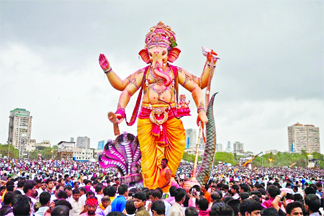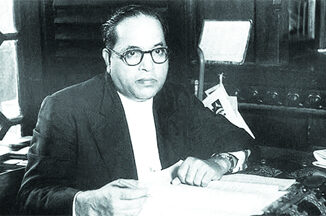
Ganesh Chaturthi also known as Vinayaka Chaturthi is one of the important Hindu festivals celebrated throughout India with a great devotion. This day is celebrated as the birthday of Lord Ganesh, the elephant-headed son of Lord Shiva and Goddess Parvati. Lord Ganesh is the symbol of wisdom, prosperity and good fortune.
Ganesh Chaturthi is celebrated on Shukla Chaturthi of the Hindu month of Bhadra (generally falls between August and September).
This year, the festival will be celebrated on August 27.
This festival is celebrated by Hindus with a great enthusiasm. People bring idols of Lord Ganesh to their homes and do worship. The duration of this festival varies from 1 day to 11 days, depending on the place and tradition. On the last day of the festival the idols are taken out in a colorful and musical procession and immersed traditionally in water.
As per Hindu mythology Lord Ganesh is considered as “Vigana Harta” (one who removes obstacles) and “Buddhi Pradaayaka” (one who grants intelligence). This festival is very important for students, they worship Lord Ganesh to illumine their minds.
The festival was celebrated as a public event since the days of Maratha King Shivaji (1630–1680). However, the public festival as celebrated in Maharashtra today, was introduced by Bhausaheb Laxman Javale in 1892 by installing first Sarvajanik (Public) Ganesh idol- Shrimant Bhausaheb Rangari Ganpati, Bhudwar Peth, in Pune. The first meeting regarding starting the Sarvajanik Ganesh utsav took place under the leadership of Bhausaheb Laxman Javale at his residence (Bhudwar Peth) now known as Bhau Rangari Bhavan. In 1893 Lokmanya Tilak praised the concept of Sarvajanik Ganesh Utsav in Kesari Newspaper. In 1894, he installed Ganesh idol in Kesari wada, Pune too and started preaching Ganesh Utsav.
While celebrated all over India, it is grandest and most elaborate of them especially in Maharashtra, Karnataka, Telangana, Tamilnadu, Kerala, Andhra Pradesh, Goa and in other parts of Western India and Southern India. Outside India, it is celebrated widely in Terai region of Nepal and by the Hindu diaspora in the United States, Canada, Mauritius, and other places.
Legend of Ganesha
Traditional Hindu about Ganesha tell that Parvati, the consort of Shiva, created Ganesha out of sandalwood paste that she used for her bath and breathed life into the figure. She then set him the task of guarding her door while she bathed. Shiva, who had gone out, returned and as Ganesha didn’t know him, didn’t allow him to enter. After the combat between Ganesha and Shiva Ganas, finally angry Shiva severed the head of the child. Parvati seeing this became enraged and Shiva then promised that her son will be alive again. The devas searched for the head of dead person facing North, but they found only the head of an elephant. They brought the head of the elephant and Shiva fixed it on the child’s body and brought him back to life. Lord Shiva also declared that from this day the boy would be called Ganesha (Gana Isha : Lord of Ganas).
According to the Linga Purana, Ganesha was created by Lord Shiva and Goddess Parvati at the request of the Devas for being a Vighnakartaa (obstacle-creator) in the path of Rakshasas, and a Vighnahartaa (obstacle-averter) to help the Devas achieve fruits of their hard work.
Celebration, rituals and tradition
Weeks or even months before Ganesha Chaturthi, artistic clay models of Lord Ganesha are made for sale by skilled artisans. They are beautifully decorated and depict Lord Ganesha in vivid poses. The size of these statues may vary from 3/4 of an inch to over 70 feet.
Ganesha Chaturthi starts with the installation of these Ganesha statues in colorfully decorated homes and specially erected temporary structures mandapas (pandals) in every locality. The pandals are erected by collecting monetary contributions and are decorated specially for the festival, by using decorative items like flower garlands, lights, etc. and at times have theme based decorations.
The priest then with the chanting of mantras invokes the presence of Ganesha using the statue as a channel, or body for his energy. This ritual is the Pranapratishhtha. After this the ritual called as Shhodashopachara (16 ways of paying tribute) follows. Coconut, jaggery, modaks, durva (trefoil) blades of grass and red flowers are offered. The statue is anointed with red unguent, typically made of kumkum and sandalwood paste. Throughout the ceremony, Vedic hymns from the Rig Veda, the Ganapati Atharvashirsa, Upanishad, and the Ganesha stotra from the Narada Purana are chanted.
History
It is not known when and how Ganesh Chaturthi was first celebrated. Ganesh festival was being celebrated as a public event in Pune since the times of Shivaji (1630–1680), the founder of the Maratha Empire. The Peshwas, the de facto hereditary administrators of the Empire from 1749 till its end in 1818, encouraged the celebrations in their administrative seat Pune as Ganesha was their family deity (Kuladevata). With the fall of the Peshwas, Ganesh festival lost state patronage and became a private family celebration again in Maharashtra till its revival by Indian freedom fighter and social reformer Lokmanya Tilak.
The public festival as celebrated in Maharashtra today, was introduced by Bhausaheb Laxman Javale in 1892 by installing first Sarvajanik (Public) Ganesh idol. This followed a meeting at his residence, which was attended by, amongst others, Balasaheb Natu, and Krishnajipant Khasgiwale. Khasgiwale on his visit to the Maratha ruled princely state of Gwalior had seen the tradition of public celebration still maintained and brought it to the attention of his friends in Pune.
In 1893 Lokmanya Tilak praised the concept of Sarvajanik Ganesh Utsav in his newspaper, Kesari, and the next year he installed a Ganesh idol in Kesari Wada too. Tilak’s efforts transformed the annual domestic festival into a large, well-organized public event. Tilak recognized the wide appeal of the deity Ganesha as “the god for everybody”, and popularized Ganesh Chaturthi as a national festival in order “to bridge the gap between Brahmins and ‘non-Brahmins’ and find a context in which to build a new grassroots unity between them”, and generate nationalistic fervour among people in Maharashtra against the British colonial rule. Tilak was the first to install large public images of Ganesh in pavilions, and also established the practice of submerging the idols in rivers, sea, or other pools of water on the tenth day after Ganesh Chaturthi.
Under Tilak’s encouragement, the festival facilitated community participation and involvement in the form of intellectual discourses, poetry recitals, performances of plays, musical concerts, and folk dances. It served as a meeting ground for people of all castes and communities in times when, in order to exercise control over the population, the British discouraged social and political gatherings.





Be the first to comment